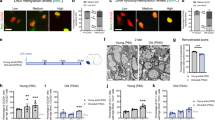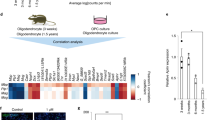Abstract
The efficiency of remyelination decreases with age, but the molecular mechanisms responsible for this decline remain only partially understood. In this study, we show that remyelination is regulated by age-dependent epigenetic control of gene expression. In demyelinated young brains, new myelin synthesis is preceded by downregulation of oligodendrocyte differentiation inhibitors and neural stem cell markers, and this is associated with recruitment of histone deacetylases (HDACs) to promoter regions. In demyelinated old brains, HDAC recruitment is inefficient, and this allows the accumulation of transcriptional inhibitors and prevents the subsequent surge in myelin gene expression. Defective remyelination can be recapitulated in vivo in mice receiving systemic administration of pharmacological HDAC inhibitors during cuprizone treatment and is consistent with in vitro results showing defective differentiation of oligodendrocyte progenitors after silencing specific HDAC isoforms. Thus, we suggest that inefficient epigenetic modulation of the oligodendrocyte differentiation program contributes to the age-dependent decline in remyelination efficiency.
This is a preview of subscription content, access via your institution
Access options
Subscribe to this journal
Receive 12 print issues and online access
$209.00 per year
only $17.42 per issue
Buy this article
- Purchase on Springer Link
- Instant access to full article PDF
Prices may be subject to local taxes which are calculated during checkout








Similar content being viewed by others
References
Gensert, J.M. & Goldman, J.E. Endogenous progenitors remyelinate demyelinated axons in the adult CNS. Neuron 19, 197–203 (1997).
Dawson, M.R. et al. NG2-expressing glial progenitor cells: an abundant and widespread population of cycling cells in the adult rat CNS. Mol. Cell. Neurosci. 24, 476–488 (2003).
Zhao, C. et al. Stem cells, progenitors and myelin repair. J. Anat. 207, 251–258 (2005).
Blakemore, W.F. Remyelination of the superior cerebellar peduncle in the mouse following demyelination induced by feeding cuprizone. J. Neurol. Sci. 20, 73–83 (1973).
Woodruff, R.H. & Franklin, R.J.M. The expression of myelin protein mRNAs during remyelination of lysolecithin-induced demyelination. Neuropathol. Appl. Neurobiol. 25, 226–235 (1999).
Patrikios, P. et al. Remyelination is extensive in a subset of multiple sclerosis patients. Brain 129, 3165–3172 (2006).
Patani, R. et al. Remyelination can be extensive in multiple sclerosis despite a long disease course. Neuropathol. Appl. Neurobiol. 33, 277–287 (2007).
Albert, M. et al. Extensive cortical remyelination in patients with chronic multiple sclerosis. Brain Pathol. 17, 129–138 (2007).
Franklin, R.J.M. Why does remyelination fail in multiple sclerosis? Nat. Rev. Neurosci. 3, 705–714 (2002).
Dubois-Dalcq, M. et al. Enhancing central nervous system remyelination in multiple sclerosis. Neuron 48, 9–12 (2005).
Miller, R.H. & Mi, S. Dissecting demyelination. Nat. Neurosci. 10, 1351–1354 (2007).
Shields, S.A. et al. Remyelination occurs as extensively but more slowly in old rats compared to young rats following gliotoxin-induced CNS demyelination. Glia 28, 77–83 (1999).
Li, W.W. et al. Females remyelinate more efficiently than males following demyelination in the aged but not young adult CNS. Exp. Neurol. 202, 250–254 (2006).
Sim, F.J. et al. The age-related decrease in CNS remyelination efficiency is attributable to an impairment of both oligodendrocyte progenitor recruitment and differentiation. J. Neurosci. 22, 2451–2459 (2002).
Woodruff, R.H. et al. Platelet-derived growth factor regulates oligodendrocyte progenitor numbers in adult CNS and their response following CNS demyelination. Mol. Cell. Neurosci. 25, 252–262 (2004).
Wolswijk, G. Oligodendrocyte regeneration in the adult rodent CNS and the failure of this process in multiple sclerosis. Prog. Brain Res. 117, 233–247 (1998).
Chang, A. et al. NG2-positive oligodendrocyte progenitor cells in adult human brain and multiple sclerosis lesions. J. Neurosci. 20, 6404–6412 (2000).
Chang, A. et al. Premyelinating oligodendrocytes in chronic lesions of multiple sclerosis. N. Engl. J. Med. 346, 165–173 (2002).
Hinks, G.L. & Franklin, R.J.M. Delayed changes in growth factor gene expression during slow remyelination in the CNS of aged rats. Mol. Cell. Neurosci. 16, 542–556 (2000).
Zhao, C. et al. Differences in the early inflammatory responses to toxin-induced demyelination are associated with the age-related decline in CNS remyelination. Neurobiol. Aging 27, 1298–1307 (2006).
O'Leary, M.T. et al. Increasing local levels of IGF-I mRNA expression using adenoviral vectors does not alter oligodendrocyte remyelination in the CNS of aged rats. Mol. Cell. Neurosci. 19, 32–42 (2002).
Arnett, H.A. et al. bHLH transcription factor Olig1 is required to repair demyelinated lesions in the CNS. Science 306, 2111–2115 (2004).
Gokhan, S. et al. Combinatorial profiles of oligodendrocyte-selective classes of transcriptional regulators differentially modulate myelin basic protein gene expression. J. Neurosci. 25, 8311–8321 (2005).
Liu, A. et al. The glial or neuronal fate choice of oligodendrocyte progenitors is modulated by their ability to acquire an epigenetic memory. J. Neurosci. 27, 7339–7343 (2007).
He, Y. et al. The transcription factor Yin Yang 1 is essential for oligodendrocyte progenitor differentiation. Neuron 55, 217–230 (2007).
Lyssiotis, C.A. et al. Inhibition of histone deacetylase activity induces developmental plasticity in oligodendrocyte precursor cells. Proc. Natl. Acad. Sci. USA 104, 14982–14987 (2007).
Shen, S. et al. Histone modifications affect timing of oligodendrocyte progenitor differentiation in the developing rat brain. J. Cell Biol. 169, 577–589 (2005).
Matsushima, G.K. & Morell, P. The neurotoxicant, cuprizone, as a model to study demyelination and remyelination in the central nervous system. Brain Pathol. 11, 107–116 (2001).
Kondo, T. & Raff, M. Basic helix-loop-helix proteins and the timing of oligodendrocyte differentiation. Development 127, 2989–2998 (2000).
Shen, S. et al. Epigenetic memory loss in aging oligodendrocytes in the corpus callosum. Neurobiol. Aging 29, 452–463 (2008).
Irvine, K.A. & Blakemore, W.F. Age increases axon loss associated with primary demyelination in cuprizone-induced demyelination in C57BL/6 mice. J. Neuroimmunol. 175, 69–76 (2006).
Mason, J.L., Langaman, C., Morell, P., Suzuki, K. & Matsushima, G.K. Episodic demyelination and subsequent remyelination within the murine central nervous system: changes in axonal calibre. Neuropathol. Appl. Neurobiol. 27, 50–58 (2001).
Zhao, C., Li, W.W. & Franklin, R.J.M. Differences in the early inflammatory responses to toxin-induced demyelination are associated with the age-related decline in CNS remyelination. Neurobiol. Aging 27, 1298–1307 (2006).
Lindvall, O. & Kokaia, Z. Stem cells for the treatment of neurological disorders. Nature 441, 1094–1096 (2006).
Charles, P. et al. Re-expression of PSA-NCAM by demyelinated axons: an inhibitor of remyelination in multiple sclerosis? Brain 125, 1972–1979 (2002).
Back, S.A. et al. Hyaluronan accumulates in demyelinated lesions and inhibits oligodendrocyte progenitor maturation. Nat. Med. 11, 966–972 (2005).
John, G.R. et al. Multiple sclerosis: re-expression of a developmental pathway that restricts oligodendrocyte maturation. Nat. Med. 8, 1115–1121 (2002).
Stidworthy, M.F. et al. Notch1 and Jagged1 are expressed after CNS demyelination, but are not a major rate-determining factor during remyelination. Brain 127, 1928–1941 (2004).
Tang, D.G. et al. Long-term culture of purified postnatal oligodendrocyte precursor cells. Evidence for an intrinsic maturation program that plays out over months. J. Cell Biol. 148, 971–984 (2000).
Marin-Husstege, M. et al. Histone deacetylase activity is necessary for oligodendrocyte lineage progression. J. Neurosci. 22, 10333–10345 (2002).
Liu, A. et al. Oligodendrocyte process outgrowth in vitro is modulated by epigenetic regulation of cytoskeletal severing proteins. Glia 44, 264–274 (2003).
Hsieh, J. et al. Histone deacetylase inhibition-mediated neuronal differentiation of multipotent adult neural progenitor cells. Proc. Natl. Acad. Sci. USA 101, 16659–16664 (2004).
Liu, A. et al. A molecular insight of Hes5-dependent inhibition of myelin gene expression: old partners and new players. EMBO J. 25, 4833–4842 (2006).
Le, N. et al. Analysis of congenital hypomyelinating Egr2Lo/Lo nerves identifies Sox2 as an inhibitor of Schwann cell differentiation and myelination. Proc. Natl. Acad. Sci. USA 102, 2596–2601 (2005).
Marks, P.A. et al. Inhibitors of histone deacetylase are potentially effective anticancer agents. Clin. Cancer Res. 7, 759–760 (2001).
Camelo, S. et al. Transcriptional therapy with the histone deacetylase inhibitor trichostatin A ameliorates experimental autoimmune encephalomyelitis. J. Neuroimmunol. 164, 10–21 (2005).
Natarajan, C. & Bright, J.J. Curcumin inhibits experimental allergic encephalomyelitis by blocking IL-12 signaling through Janus kinase-STAT pathway in T lymphocytes. J. Immunol. 168, 6506–6513 (2002).
Chen, P.S. et al. Valproic acid and other histone deacetylase inhibitors induce microglial apoptosis and attenuate lipopolysaccharide-induced dopaminergic neurotoxicity. Neuroscience 149, 203–212 (2007).
Dupree, J.L. et al. Galactolipids in the formation and function of the myelin sheath. Microsc. Res. Tech. 41, 431–440 (1998).
Dahl, J.A. & Collas, P. Q2ChIP, a quick and quantitative chromatin immunoprecipitation assay unravels epigenetic dynamics of developmentally regulated genes in human carcinoma cells. Stem Cells 25, 1037–1046 (2007).
Acknowledgements
This work was supported by grants from US National Institutes of Health National Institute of Neurological Disorders and Stroke (NS042925 and NS52738 to P.C.-B.), the National Multiple Sclerosis Society (NMSS RG-3957 P.C.-B.), the MS Research Foundation (to P.C.-B.) and Research into Ageing (to R.J.M.F.). We thank J. Williamson for superb assistance with electron microscopy and acknowledge C. Ghiani (University of California Los Angeles) for the gift of the microglial BV-2 cell line.
Author information
Authors and Affiliations
Contributions
S.S. and J.S. performed the majority of the experiments and data analysis. J.L. contributed to the in vivo experiments and V.A.S. to the silencing experiments. J.D. performed the ultrastructural analysis. R.J.M.F. contributed to the initial phase of the project and helped with text writing and editing. P.C.-B. was responsible for planning the experiments, supervising the project, critically analyzing the results and writing the manuscript.
Corresponding author
Supplementary information
Supplementary Text and Figures
Supplementary Figures 1–7 and Supplementary Methods (PDF 3257 kb)
Rights and permissions
About this article
Cite this article
Shen, S., Sandoval, J., Swiss, V. et al. Age-dependent epigenetic control of differentiation inhibitors is critical for remyelination efficiency. Nat Neurosci 11, 1024–1034 (2008). https://doi.org/10.1038/nn.2172
Received:
Accepted:
Published:
Issue Date:
DOI: https://doi.org/10.1038/nn.2172
This article is cited by
-
Aging and age-related diseases with a focus on therapeutic potentials of young blood/plasma
Naunyn-Schmiedeberg's Archives of Pharmacology (2024)
-
Oligodendrocyte progenitor cells in Alzheimer’s disease: from physiology to pathology
Translational Neurodegeneration (2023)
-
Oligodendrocyte death initiates synchronous remyelination to restore cortical myelin patterns in mice
Nature Neuroscience (2023)
-
Mixed methodology in human brain research: integrating MRI and histology
Brain Structure and Function (2023)
-
From methylation to myelination: epigenomic and transcriptomic profiling of chronic inactive demyelinated multiple sclerosis lesions
Acta Neuropathologica (2023)



